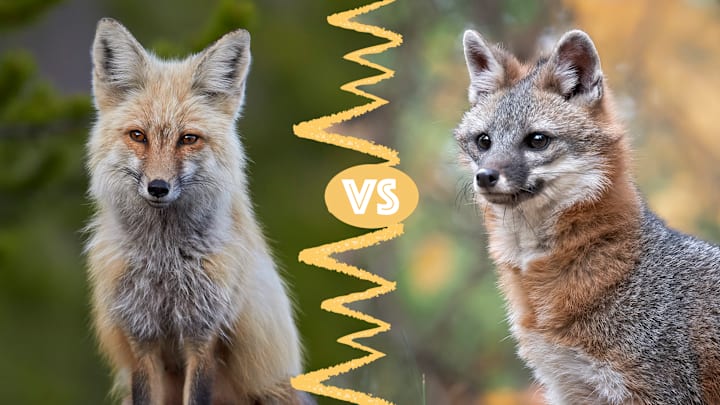You may think that if you’ve seen one fox, you’ve seen them all. But while they’re all part of the Canidae (dog) family; communicate using intricate yips, barks, and squeals; and follow nocturnal and crepuscular activity patterns, there’s more than one type of fox slinking around the woods of North America—and when you really start to compare them, you’ll quickly realize there are many differences between them.
- How to Visually Tell the Difference Between Red and Gray Foxes
- Gray Fox vs. Red Fox: Habitats and Range
- What do red and gray foxes eat?
Here’s a closer look at two commonly found North American species—the gray fox and the red fox—and some tips on how to tell them apart.
Species | Latin Name | Coat Color | Face Shape | Habitat |
|---|---|---|---|---|
Red Fox | Vulpes vulpes | Can be red, black, silver, and red/silver; will usually have black legs and black ear tips, and often has a white tail tip | Long, pointy snouts with pointier, dog-like ears | Urban, suburban, and agricultural neighborhoods, as well as forests and marshes |
Gray Fox | Urocyon cinereoargenteus | Salt and pepper gray, with a black dorsal stripe and black-tipped tails | Shorter, stouter snout with slightly rounded, more cat-like ears | Forests and marshes, usually farther away from human settlements |
How to Visually Tell the Difference Between Red and Gray Foxes
There are several ways to visually tell the difference between a red fox (Vulpes vulpes) and a gray fox (Urocyon cinereoargenteus). Hint: Relying on their name alone doesn’t help much! Despite their moniker, red foxes can have a variety of color morphs, including yellowish red, black, silver, albino, or even a cross between red and silver, which is called a “cross fox.” Red foxes do, however, typically have black legs, a white tail tip, and black ear tips.

Most gray foxes, on the other hand, have dark, grizzled gray salt-and-pepper coats, with a black stripe that runs down their backs, and black-tipped tails. They’ll occasionally have some rusty or reddish coloration around their necks and on their legs.
From tip to tail, both species of foxes measure between 31 to 44 inches long and weigh between 7 to 15 pounds, with males being slightly larger than the females. The gray fox often appears significantly smaller because it has shorter legs and a stockier body.
There are differences in their faces, too. Red foxes look much more like dogs—they have longer snouts and pointy, canine-looking ears. Gray foxes, on the other hand, have a more cat-like appearance, with smaller snouts and more rounded ears.
Gray Fox vs. Red Fox: Habitats and Range
Both red and gray foxes live in North America, and their ranges overlap to cover most of the U.S. The red fox’s range extends north into most of Canada—in recent years, warming temperatures have allowed them to encroach upon the arctic fox’s territory—while the gray fox can be found farther south, into Mexico Central America.

When it comes to habitats, red foxes thrive in a wide variety of places: You can spot them in urban, suburban, and agricultural neighborhoods, as well as in forests and marshes. They’ll dig dens (or sometimes claim cozy spots another species had previously dug up) to give birth and raise their young. It isn’t unusual for someone to discover a red fox family has set up camp beneath their backyard shed or deck.
Gray foxes, on the other hand, generally choose to live farther away from humans; you’ll typically find them deeper in the woods where there’s more tree cover, and closer to lakes, rivers, and marshes. They’ll select a den site that’s in some sort of rocky crevice, or even in a hole in a tree. Unlike other fox species, gray foxes have impressive climbing skills, thanks to their sharp, curved claws. They can also rotate their forelegs, which helps them grip tree trunks.
What do red and gray foxes eat?
Both foxes are opportunistic foraging omnivores. They’ll feast on birds, insects, small mammals—gray foxes have a particular penchant for rabbits—and berries. If food is abundant, they’ll cache it away, burying it for later use under piles of leaves, snowbanks, or stacks of brush.
Read More Stories About Foxes Here:
